
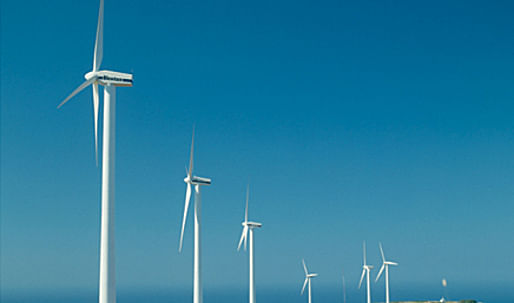
There's big political buzz of late around the term "Energy Independence." The notion tends to have a rippling effect: from the economy, to the environment, to foreign policy, our addiction to energy affects nearly every aspect of our policy. And it also affects our lives. I'm not referring here solely to concerns related to the "green" side of the issue—climate change and the assorted meteorological calamities therein—but rather to the basest of political motivations, because even the "I vote for my tax break" crowd will take heed of $4/gallon gas.

United States Annual Average Wind Power
So how can we most speedily disentangle ourselves from the "largest transfer of wealth in the history of mankind?" (And that's $700 billion dollars/year for anyone who's counting). And what do Messrs. Obama and McCain offer as antidote? As it turns out, the energy plans of the candidates are quite similar, each proposing that we (in no particular order): 1. expand domestic production; 2. create financial incentives (like "cap and trade" plans) to reduce carbon use; and 3. improve the transportation sector.
Sounds good, I guess, but I find myself asking, "what exactly does "1" refer to?" Opening up ANWR? Reincarnating the electric car? Harnessing the power of sun and tide and wind? In all likelihood—remember, we're dealing with politicians—it means some ostensibly equitable combination of all of the above (though given the marauding hordes of St. Paul, with their atavistic chants of "drill, baby, drill," I think we can peg them for a certain bias). If we must speculate which of the two promises more investment in alternative energy, I'll go with Obama, whose minions at the previous week's festivities seemed somewhat more enthusiastic about such hippie throwbacks as solar, tidal, geothermal, and wind. And there were tangible signs of support as well, like the gigantic Vestas wind turbine blade displayed out front, a convincing emblem of the democrats' (and Obama's) commitment to alternative energy: the Danish wind turbine manufacturer has already opened one plant in Colorado and will soon open two more (an investment of $293 million). Sign #2 was the presence of everybody's newly beloved former oilman and current peddler of wind, T. Boone Pickens.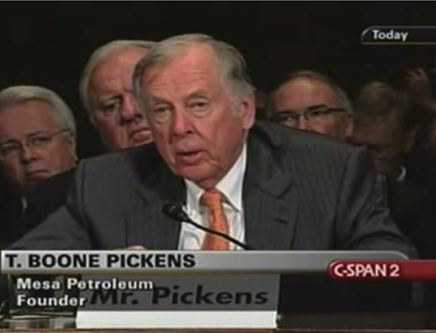
T. Boone Pickens
Oilman Pickens has lately re-invented himself as the champion of good old home grown energy. If you haven't seen the ads, the "Pickens' Plan" identifies the "wind corridor," a vast swath of land extending from Canada down to Texas, as the world's most abundant source. Thus T. Boone proposes a "bridge" to energy independence which involves harnessing this wind through investment in new infrastructure (turbines and grid expansion, production of which will also revitalize depressed mid-west economies); then swapping this wind-borne electricity for the natural gas component of the current scheme (representing about 22% of use); then transferring the natural gas to power automobiles. The new-found natural gas will, according to Pickens, reduce our dependence on foreign oil by about one-third, or $230 billion a year.
The "wind corridor," according to the "Picken's Plan"
Notwithstanding the many criticisms of Pickens and his (potentially) self-serving plan (increasing price of raw elements like steel and carbon fiber needed for turbine production; obscuring the need to diversify in our approach to solving energy addiction; and charges that Pickens is in it for mere financial gain), the idea intrigues. If the science is accurate, it rather takes the breath away to think that we could power nearly one quarter of the grid with wind, and—love him or hate him—having Pickens as pitchman certainly suggests the idea has gone mainstream.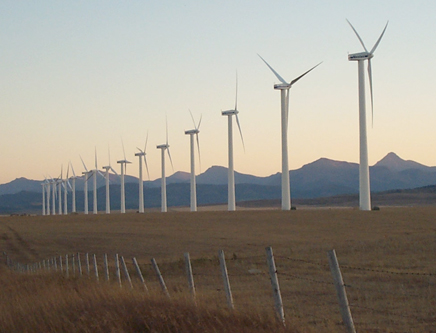
But while Pickens' presence at the convention was his own doing, Vestas was invited. And in linking his party to this—the largest manufacturer (or should I say "harnesser?") of wind energy in the world, Obama, et. al. seem to have done their homework. The company had a 23 per cent market share in 2007; they generate more than 60 million MWh of electricity every year, which is enough to supply every household in a country as large as Spain. And if you still picture the clumsy, four-armed, wooden-webbed prototypes when you think of windmills, think again. The tower and blades of Vestas' flagship model, the V80 2.0 MW, are constructed of tubular steel and fiberglass-reinforced epoxy, respectively. Towers come in different heights to suit area conditions (198 ft., 221 ft., 257 ft., and 330 ft.), and the blades span about 130 ft., which makes for an "area swept" of approximately 16,600 sq. ft. And they aren't just brawny pillars of moving parts either: the "nacelle" of the V80 (the housing that joins tower to rotor) contains a micro-processor-laden control center that fine tunes the turbine's behavior in relation to the condition of the wind. Thus "OptiTip" technology "rotates the blades around their longitudinal axes, thus ensuring continuous adjustment to maintain optimal blade angles in relation to the prevailing wind," while also keeping sound levels low. And the "OptiSpeed" generator helps control turbine rotor speed, choosing the most efficient number of rotations per minute relative to wind speed.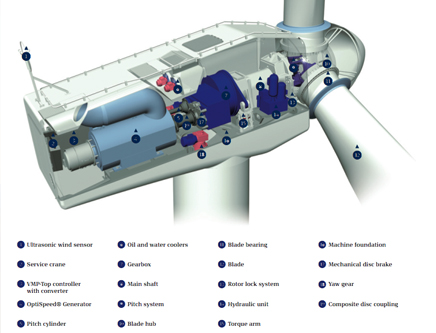
"Nacelle" of Vestas' V80 wind turbine (Source: Vestas)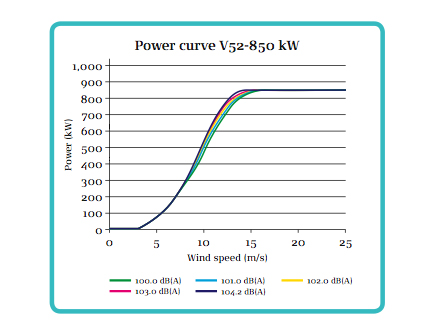
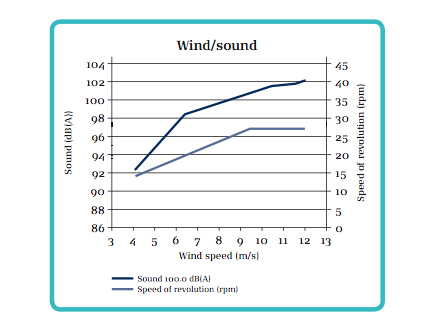
Power curve for a Vestas V52-850 kW turbine (top) and wind/sound graph (Source: Vestas)
In sum, Vestas turbines are a new brand of intelligent jolly giant. And while they are an imposing presence on the landscape, the aesthetic is rather pleasing. Set on high-topped ridges, amid the lush greens or autumnal rusts of the mid-West landscape, they resemble steely, multi-armed sentinals, the resounding whoosh of their unremitting revolutions a burgeoning harmony to an oil-free world—any modern-day Don Quixotes who come along, eager to combat the promising pace of change, will find themselves hopelessly outmatched.
Joseph Starr lives in the Colorado mountains. He has been an English teacher, a Spanish translator, a no-nonsense bartender, a cantankerous bus driver, and a failed carpenter. He enjoys sitting, reclining, and using household appliances--all of which give him great authority as a product reviewer for 3rings .
More articles by Joseph at 3rings:
EcoTimber’s Engineered Wood Floors 
Dyson Airblade

Chinatown by Waterfall
At Salone: BASF + Grcic + Plank = Myto
Synthetic Stone Columns 
Robert Stadler’s Dissipations
DecoTurf for Tennis’ Best

Executive Normal by Jean Nouvel
Creative Commons License
This work is licensed under a Creative Commons License .
/Creative Commons License
15 Comments
it's fun to read of a billionaire oil man turned environmental savior -- at least his heart is finally in the right place.
pickens is a new sort of entrepreneur who seeks renewable resources for exploitation in addition to non-renewables. His biggest venture is an attempt to export water down to Dallas from the pan handle. Wind is just how he is attempting to greenwash up his swift-boat politics.
Lord! You are so cynical. Pickens is what he has always been: an entrepreneur. His plan, if you bother to read it is flat-out economic reasoning. When he was starting in oil, there were few acknowledged or studied environmental concerns, it was a booming industry and it was an obvious choice for a capitalist-minded geologist. He has identified an emerging resource of value.
He's not greening-up, and his politics are not a part of his analysis. Otherwise, he wouldn't be where he is.
Wait - so who is the cynic?? Me or 'treekiller'? Ha.
Either way, I don't think we can automatically assume that any person whom does something for economic reason cannot at the same time be motivated by a greater calling as well. Yes, Pickens probably wouldn't be pushing wind energy if it wasn't economically viable, but what good would that do for anyone anyway if he were lobbying a solution that would potentially squander money. Smart people of influence know sustainability must be propagated via an economic sound strategy or it will NEVER be adopted.
For all the criticism rightfully applied to Pickens, I think this is a good and necessary direction. We're not going to see (or be involved in) any major sweeping energy transformations without Big Money's interest. Pickens clearly knows how to get money, and if he's choosing to direct his energy towards, ahem, energy, then all the better.
i think treekiller points to an interesting subject here and i am surprised you guys are quick to write him off.
it is one thing to agree on the mechanical design aspects of the wind power blade, but another to think in terms of its economic tract.
we cannot look into sustainability, energy production and its growth as a way of life without looking into economic and investment systems and their historical, future patterns.
i was expecting a little more attention to this investment side of things, rather than how the carbon fiber integrated into manufacturing of this machinery. and, which millioner is investing in it.
it is okay but not as critical as treekiller's attempt to draw attention to the models of investing into clean and sustainable energy production.
pickens entry into wind energy business might be welcomed now, but how this should function within the future developments cannot be an off limits discussion.
we can stop looking at it just as a product development, but a way of life, all the way to economic development of its own existence.
and perhaps, with alternative adaptation, investment and development systems as well.
a lot of ideas that are now being adopted/studied by developed nations as green and sustainable methods for living, aren't developed by 'big money.'
as a hint for further discussion...
the windmills mean nothing on their own. currently in minnesota, there is not enough transmission line capacity to send power produced by windmills to consuming markets. the electric grid is constructed on an always-on paradigm, and windmills are usually located in areas that are underserved by grid infrastructure. massive investment in transmission infrastructure will be required to deliver windmill generated electricity to markets.
the other issue is storage. windmills can't respond to peak power demands like power plants can. windmills are nonlinear power-generating devices, and cannot be controlled in the way that even hydro can. let's also not forget about the location of the 'windbelt' which corresponds neatly with areas of high agricultural production.
no such thing as a free lunch.
politics are very much part of the pickens plan - if he didn't need the attention or to shift public perception to gain approval/subsides for his projects, there wouldn't be saturation advertising. Unlike Al, T. Boone has his money on the line and the project should be evaluated on its own merits - not based on the savvy spin.
While there are areas of the world well served by transmission capacity and wind potential, they are few and far between. It is far easier to move coal in mile-long train cars from wyoming to georgia then it is to create the far more visible transmission lines. Railroads created the western landscape (and part of the east too), but high tension lines have always been a juxtaposition on the landscape that have strange implications that most don't want to recognize. Infrastructural corridors (RR, pipelines, powerlines, aqueducts) are the bastard child of planners - we spend far more effort and public discourse looking at new highways or windmills in 'scenic' locations. Now the 'Drill baby drill' folks want oil platforms in places that windmills were rejected - an when a windmill fails, all you get is a few shards of carbon fiber and gears. when an oil platform fail, you have catastrophic environmental damage. Those corridors tend to fragment habitat and disregard the landscape for the engineers love of straight vectors. I have yet to see an elegantly planned infrastructure corridor.
[didn't know there was a 2500 charecter limit to comments on the features]

part II
Oh, the LCA footprint of a turbine is less then a fossil fuel plant with all the emission bells and whistles - plus requires less maintenance and operations effort - but transmission lines may not ever be justified - considering that over 25% or more of electricity is lost on the way from centralized generation to the end user. Distributed generation is the wave of the future - but small wind doesn't make the grade. see the building integrated wind turbines thread for more wind discussion and the statistics showing that exponentially more birds die from collision with power lines then with wind turbines.
storage is less of an issue with the robustness of the grid and diversity of generation sources. There are even viable thermal storage systems for solar thermal electric generation that keep the juice flowing into the evening.
ag and wind power are a land-use good match- the development of wind power requires large 'empty' spaces to minimize turbulence. we can't install 300' towers for 2mw turbines in suburbia. if wind power can keep sprawl in check, then BRAVO! I applaud the farmers who have found another income source that has a minimal footprint. I may be cynical about t. boone's motivation, but that doesn't mean that I can't be a wind fan.
oh, we should get phil henshaw's thoughts on this topic. I'll drop him a note. ..
Hi there! I haven't read the whole thread, but gather the question is whether we can grow our way our of the impacts of growth, using crafty wind power investments to do it. I've been spending this week trying to find out why none of the media are aware of the vigorous discussions of why a financial meltdown happens naturally when finances need to multiply for their own stability in a world that doesn't. Even JM Keynes pointed out the problem. Now our whole blithering world of backscratchers seeing it happen acts as if it's a total surprise I pegged the beginning of it 15 months ago, as beginning “the big crunch”, when the fuel/food price war showed the whole system’s resource steering choices running into conflict with each other and fishtailing. There is a great deal of discussion of these sorts of overshoot and collapse subjects, but our professional media define the public conversation in the image of themselves, and so inadvertently shut out all the other conversations!
I'd be very much for using wind for power on a local community scale, like to power low water use algae farms and their petrol stills, giving some local communities a readily stored and marketable energy product. If people see how to do that, that’s great. As a source of power to replace fossil fuels and grow exponentially forever, I’m less sanguine…. I'm disturbed by the fact that I've never seen a power line in any photo of a windmill, for example. There would be power lines all over it seems to me. Then there's the real jinx, that the whole premise is finding ways to grow out of our growth impacts, by adding new levels of multiplying impacts. Humans just don't think straight!
I think it's always been multiplying our solutions that's been the main problem. Because each person sees what they're creatively doing as 'a solution' it never crosses their minds to ask if it might be a problem too... Ultimately I think it's that cognitive slip, not moral failings, that has us destroying the earth, exemplified by our glaring financial meltdown predicted for decades for obvious causes by numerous competent people who turned out to be right. I'm not at all hopeful as everyone's solution still seems to be to promote growth and keep multiplying the scale, complexity and momentum of the problem. The odd thing is that what we’re avoiding by not acknowledging the problem is the real choices we’d actually have. Go figga!
t boone pickens was behind the swiftboat campaigns that helped bush beat kerrey in 04... these are the kinds of people who have made this country dependent on oil and our lifestyle of consumption and now many of them have become crusaders but none of them express guilt or poor judgement about leading the wave of how we got in this mess. a windmill ain't gonna power my escalade t bone.
Combining wind with natural gas technology makes sense to me. We need to get out of the mid east and away from oil.
SSRE
There’s a discussion of T Boon Picken’s Wind solutions on Archinect:
But, how do we get away from imported energy if we're always consuming more and more energy?
It could be interpreted as "higher math" to see a difference between an amount of something, its rate of change, and it's rates of acceleration. Maybe the confusion is that non-scientists don't realize that the same relation between rates exists for watching a cake rise as watching a bat swing as watching an economy blow up an earth.
Rates may be drawn out or bunched up, but to change the sizes of things takes rates of change to do it. It leaves me really wondering, after 50 years of environmental organizing by a very large community of committed and creative intellectual activists, that we still don't have any community awareness of the problem of addition and its rates. As long as we are driving an economy that exists only to continually add to it's rate of addition, we've got a terminal rate of change problem, and solving that is the only means of dealing with any scale problem in a meaningful way.
You might think the US doesn't seem to be changing it's energy requirements if we all just live in our homes and drive our usual route, or whatever. Say we ignore that the workhorse of the economy is thought to be building new infrastructure to expand cities and suburbs etc. Another major source of our increased energy consumption has been in importing manufactured products from around the world. That serves to export our energy consumption and pollution to China and Vietnam etc., effectively 'laundering' or impacts the way anyone trying to hide something usually does, paying someone else to do it.
Our real problem is that our laundering of impacts is designed to crank up ever faster, to multiply without end (till it quits). This week the world financial network melted down using that same "pump it till it quits" design the whole economy has. IF we ask about that queer misunderstanding this financial collapse may be the luckiest turn of events for us.
the TheNew Direction Energy Plan from the US House of Representatives - ain't the same old George W transfer of wealth to big oil... but they don't have the answers yet.
Doesn't it seem to use the usual multiplying revenues and magically vanishing impacts? It's just not sensible to remake the continental infrastructure with an accelerating crash program anyway. Hey, we just finished building it and remaking things is always more finicky than starting from scratch.
Block this user
Are you sure you want to block this user and hide all related comments throughout the site?
Archinect
This is your first comment on Archinect. Your comment will be visible once approved.